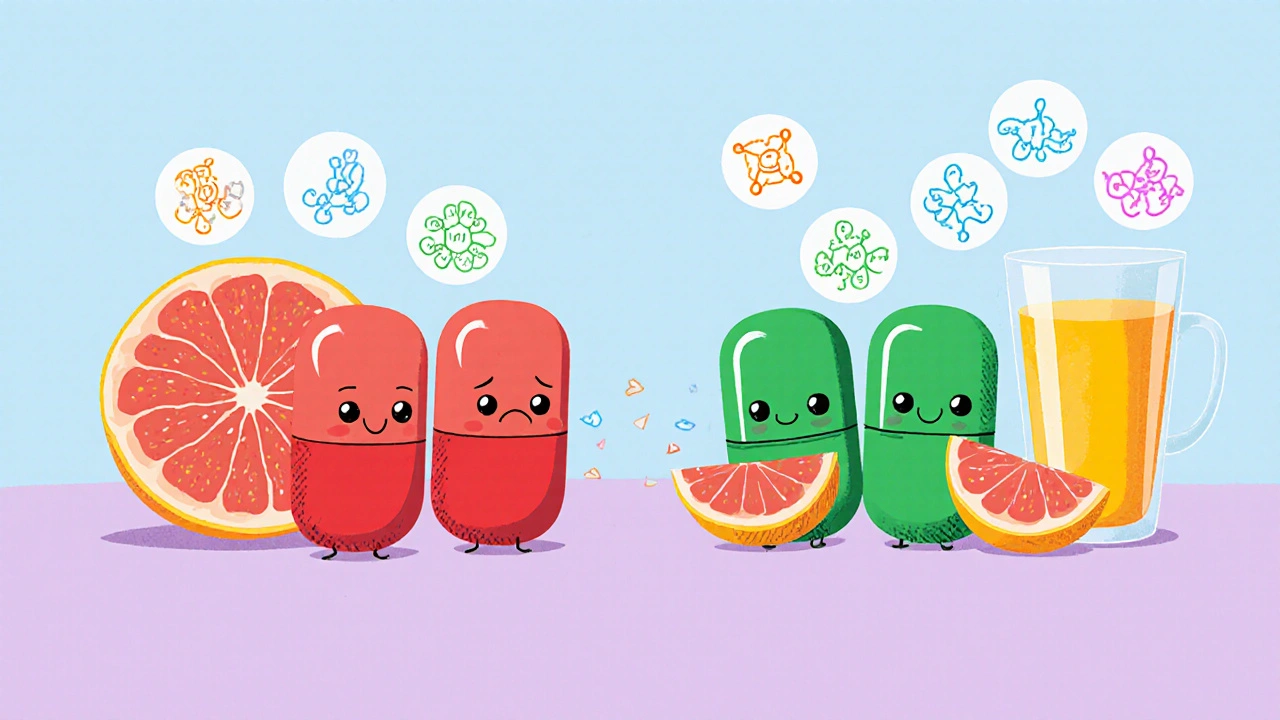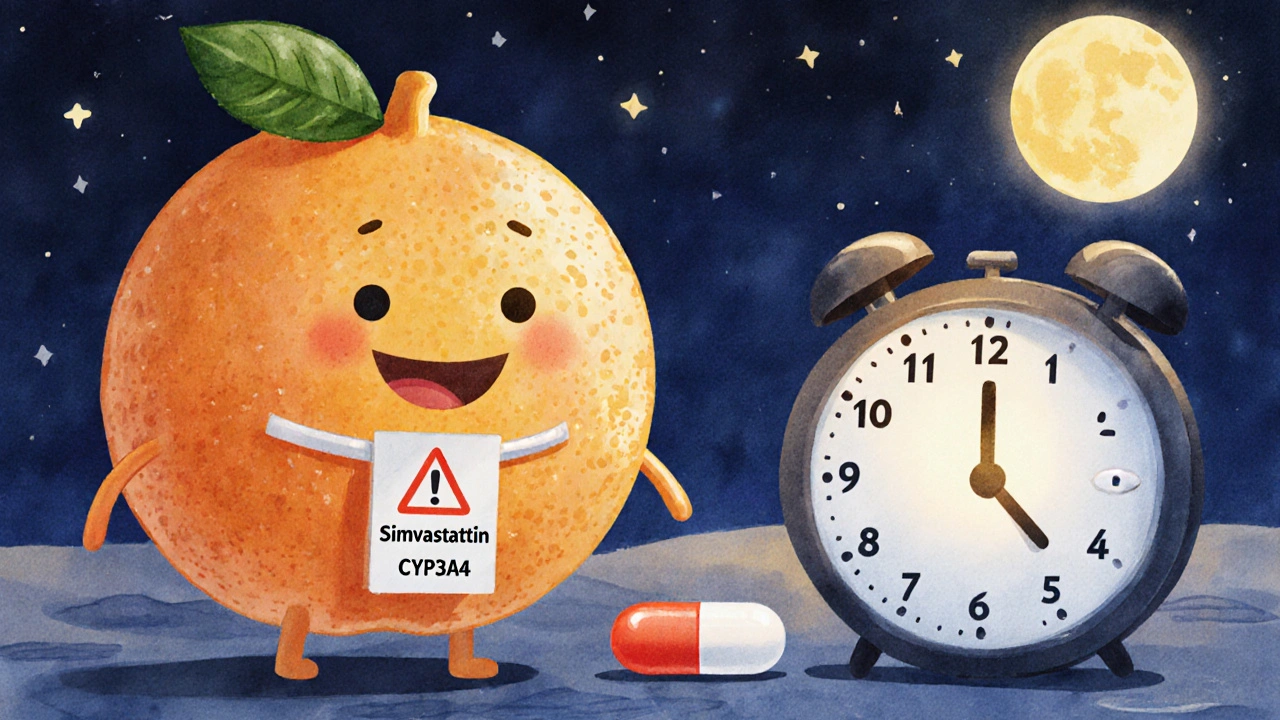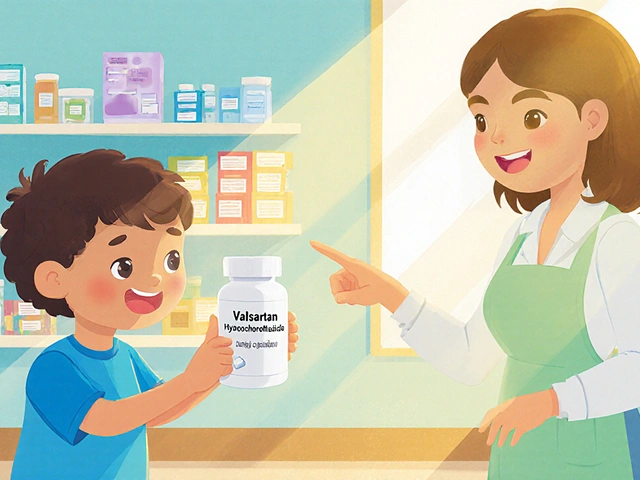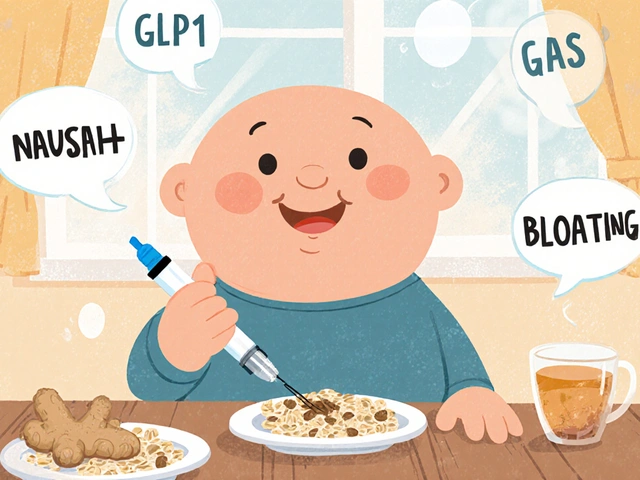Grapefruit-Statins Safety Calculator
Calculate Your Risk
Your Risk Assessment
Select your statin and consumption details to see results.
It’s a simple question: can you still eat grapefruit if you’re on a statin? For many people, the answer isn’t black and white. Grapefruit is healthy-packed with vitamin C, antioxidants, and fiber. But if you’re taking certain cholesterol-lowering drugs, that half a grapefruit or glass of juice could be more dangerous than you think.
Which Statins Are at Risk?
Not all statins react the same way to grapefruit. The problem isn’t with the fruit itself-it’s with how your body processes certain drugs. Grapefruit contains chemicals called furanocoumarins, which shut down an enzyme in your gut called CYP3A4. This enzyme normally breaks down some statins before they enter your bloodstream. When it’s blocked, too much of the drug gets absorbed, and your blood levels spike.The statins most affected are:
- Simvastatin (Zocor, FloLipid)
- Atorvastatin (Lipitor)
- Lovastatin (Mevacor)
These three rely heavily on CYP3A4 to be broken down. If you’re on one of these, grapefruit can cause your drug levels to jump by 3 to 8 times. That’s not a small change-it’s enough to raise your risk of muscle damage, kidney failure, or even rhabdomyolysis, a rare but life-threatening condition where muscle tissue breaks down and floods your bloodstream.
On the other hand, these statins are safe with grapefruit:
- Pravastatin (Pravachol)
- Rosuvastatin (Crestor)
- Fluvastatin (Lescol)
- Pitavastatin (Livalo, Zypitamag)
They’re metabolized differently-mostly by the liver or through other enzymes-so grapefruit doesn’t interfere. If you love grapefruit and are on a statin, switching to one of these might be the easiest fix.
How Much Grapefruit Is Too Much?
There’s no universal number that works for everyone, but science gives us a clear starting point. Research shows that as little as 200-250 ml (about 8 ounces) of grapefruit juice can trigger a dangerous interaction with simvastatin or atorvastatin.A 2006 study in the British Journal of Clinical Pharmacology gave 10 healthy volunteers 200 ml of grapefruit juice daily. The result? Simvastatin levels in their blood jumped 3.6 times higher than normal. Peak concentrations went up nearly 4-fold. That’s not a theoretical risk-it’s measurable, repeatable, and dangerous.
But here’s the twist: not everyone reacts the same. Some people have more CYP3A4 enzyme in their gut than others. One study found that after drinking the same 250 ml of grapefruit juice, some people saw no change in their drug levels. Others saw an 8-fold spike. Genetics, age, liver health, and even what else you’re taking can change your risk.
So what’s the official line? The FDA says: if you’re on simvastatin or atorvastatin, avoid grapefruit juice entirely. But that’s not always practical. Many patients love grapefruit and don’t want to give it up.
The Threshold: When Is It Safe?
The good news? You don’t necessarily have to quit grapefruit cold turkey.Dr. Stanley Hazen from Cleveland Clinic says that for most people, half a grapefruit or one 8-ounce glass of juice is unlikely to cause harm-especially if you take your statin at night and your grapefruit in the morning. The timing matters. Statins like simvastatin work best when taken at night, and grapefruit’s effect on CYP3A4 wears off after about 24 hours. So if you eat grapefruit in the morning and take your pill at bedtime, you might avoid the worst of the interaction.
But this only works if you’re on a standard dose. If you’re taking 80 mg of simvastatin-common for people with very high cholesterol-then even a small amount of grapefruit is risky. The European Medicines Agency says high-dose simvastatin users should avoid grapefruit completely.
And don’t think “a little bit every day” is safe. The same 200 ml you drink daily adds up. A 2021 study in Drug Metabolism and Disposition showed that daily consumption-even just one glass-can double your risk of muscle damage over time.
The FDA defines “excessive” as 1.2 liters per day (that’s five 8-ounce glasses). That’s when the risk becomes almost guaranteed. But you don’t need to hit that level to be in danger.

What About Whole Grapefruit?
Some people think eating the fruit is safer than drinking the juice. That’s a myth. The active compounds-furanocoumarins-are in the flesh and peel, not just the juice. Half a grapefruit has just as much risk as a glass of juice. The only difference is that juice is more concentrated and absorbed faster. But both can trigger the same interaction.So if you’re on simvastatin or atorvastatin, treat the whole fruit the same way you treat the juice: limit it, time it, or avoid it.
What If You’ve Been Eating Grapefruit All Along?
You’re not alone. Many people have been eating grapefruit with their statin for years without issues. That doesn’t mean it’s safe-it means you’ve been lucky.Between 1990 and 2021, only 17 cases of rhabdomyolysis were officially linked to grapefruit and statins in the FDA’s database. That sounds rare. But here’s the catch: most cases go unreported. Muscle pain, weakness, or dark urine (signs of muscle breakdown) are often dismissed as “just getting older” or “overdoing it at the gym.”
And if you’re over 65, taking other meds (like blood pressure pills or antibiotics), or have kidney or liver problems, your risk goes up. The American College of Cardiology’s 2023 guidelines say: don’t wait for symptoms. If you regularly eat grapefruit and are on a high-risk statin, talk to your doctor about switching to a safer option.

What Should You Do?
Here’s a simple plan:- Check your statin name. Is it simvastatin, atorvastatin, or lovastatin? If yes, proceed with caution.
- Don’t assume you’re fine. Just because you’ve had grapefruit for years doesn’t mean your body won’t react differently tomorrow.
- Ask your doctor about switching. Rosuvastatin or pravastatin work just as well for most people and don’t interact with grapefruit.
- If you keep eating it, stick to half a grapefruit or one 8-ounce glass of juice, and take your statin at night.
- Watch for warning signs. Muscle pain, tenderness, weakness, or dark urine? Call your doctor immediately. These could be early signs of muscle breakdown.
There’s no need to panic. But there’s also no reason to gamble. Statins save lives-they prevent heart attacks and strokes. Grapefruit doesn’t have to be the thing that undoes that protection.
What About Other Citrus Fruits?
Not all citrus is dangerous. Oranges, tangerines, and lemons don’t contain furanocoumarins. You’re safe with those. But don’t assume all citrus juices are okay. Seville oranges (used in marmalade) and pomelos are close relatives to grapefruit and can cause the same interaction. Stick to sweet oranges and lemons if you’re unsure.Bottom Line
Grapefruit isn’t the enemy. Statins aren’t the enemy. But together, they can be a problem-especially with certain types and doses. The safest path is simple: know your statin. Know your grapefruit. Talk to your doctor. And don’t assume you’re immune just because nothing’s happened yet.For most people on simvastatin or atorvastatin, avoiding grapefruit entirely is the best move. For others, a small, timed portion might be okay. But the only way to be sure? Ask your pharmacist or prescriber. Your heart will thank you.
Can I drink grapefruit juice if I take rosuvastatin?
Yes. Rosuvastatin (Crestor) is not broken down by the CYP3A4 enzyme, so grapefruit juice doesn’t affect its levels in your blood. You can safely enjoy grapefruit if you’re on rosuvastatin, pravastatin, fluvastatin, or pitavastatin. These statins are the safest choices if you like citrus.
How long does grapefruit affect statins?
The enzyme-blocking effect of grapefruit can last up to 24 hours. That’s why timing matters-if you drink grapefruit juice in the morning and take your statin at night, you reduce the risk. But daily consumption means the effect builds up over time. Even if you space them out, regular intake increases your chances of a dangerous interaction.
Is it safe to eat grapefruit once a week?
For people on simvastatin or atorvastatin, even once a week carries some risk. The interaction isn’t just about how much you eat-it’s about whether your body is genetically wired to absorb more of the drug. Some people see dangerous spikes with just one serving. If you’re unsure, it’s safer to avoid it entirely or switch to a different statin.
What are the signs of muscle damage from grapefruit-statin interaction?
Watch for unexplained muscle pain, tenderness, or weakness-especially in your shoulders, thighs, or lower back. Dark or tea-colored urine is a red flag. These could be signs of rhabdomyolysis, a serious condition where muscle breaks down and damages your kidneys. If you notice these symptoms, stop grapefruit and contact your doctor immediately.
Can I switch statins to keep eating grapefruit?
Yes. Many people switch from simvastatin or atorvastatin to rosuvastatin or pravastatin specifically to enjoy grapefruit without risk. These alternatives are just as effective for lowering cholesterol and don’t interact with grapefruit. Talk to your doctor about whether a switch is right for you.





14 Comments
james landon
Man, I’ve been eating half a grapefruit every morning with my Lipitor for years. Never had a problem. Guess I’m just lucky? My body must be one of those weird ones that doesn’t care. Still, I’ll probably stop now just to be safe-don’t wanna end up in the hospital because I liked citrus.
Also, why does everyone act like grapefruit is the devil? I mean, it’s not like I’m chugging a whole pitcher.
Jenn Clark
I switched to pravastatin last year after my pharmacist mentioned the grapefruit thing. Best decision ever. I still enjoy my morning fruit, and now I don’t have to stress about it. Honestly, it’s nice not having to play guesswork with your meds.
Also, I love that the article pointed out rosuvastatin is safe. So many people don’t know that.
L Walker
Interesting how the enzyme inhibition is dose-dependent and variable between individuals-some folks have near-zero CYP3A4 expression in the gut, others are hyper-responders. Genetics play a huge role. Also, the 24-hour window isn’t magic-some metabolites linger longer depending on liver function.
But honestly? If you’re on simvastatin and eating grapefruit daily, you’re playing Russian roulette with your kidneys. Just switch statins. It’s not that hard.
giri pranata
Bro, I’m from India and we don’t even eat grapefruit here much 😅 But I read this and thought-wow, this is so important! My uncle takes Lipitor and loves grapefruit juice. I just sent him this article. He’s gonna switch to Crestor now. Thanks for the clarity!
Also, side note: if you’re on statins, avoid Seville oranges too! They’re sneaky. 🙏
Stuart Rolland
Okay, so I’ve been on atorvastatin for six years, and I’ve been having one glass of grapefruit juice every other day because I read somewhere that spacing it out reduces risk. But now I’m reading this and realizing that even ‘every other day’ is still daily exposure, which means the enzyme inhibition is cumulative, and over time, even if you don’t feel anything, your muscle tissue might be quietly deteriorating. And that’s terrifying. I never thought about it that way. I’m switching to pravastatin next week. Also, I’ve been having this weird shoulder pain lately-maybe I should get my CK levels checked? I’m going to call my doctor tomorrow. Thanks for the wake-up call.
Also, I didn’t know pomelos were a problem. I love those. Now I’m confused. Are they just bigger grapefruits? Do they have the same compounds? I need to research this more.
Kent Anhari
So I’ve been eating grapefruit with my statin for 10 years. No issues. I’m 72, healthy, active. I think this whole thing is overblown. The FDA says ‘avoid entirely’ but they’re just covering their asses. Real people live real lives. If you’re not having symptoms, you’re probably fine. Stop scaring people with hypotheticals.
Charlos Thompson
Oh wow, so grapefruit is the Voldemort of citrus? ‘He who shall not be named’? I guess I’ll just stop eating fruit altogether then. Maybe I should start drinking distilled water and eating plain rice. Oh wait, that’s what my cholesterol was like before statins. Thanks, science.
Also, ‘don’t assume you’re immune just because nothing’s happened yet’? Wow. That’s the most passive-aggressive warning I’ve ever read. Like, I’m supposed to feel guilty for liking breakfast? Next you’ll tell me sunlight causes cancer.
Peter Feldges
While the pharmacokinetic data regarding CYP3A4 inhibition by furanocoumarins is robust, the clinical incidence of rhabdomyolysis remains exceedingly rare-even among high-risk populations. The risk-benefit ratio of grapefruit consumption in statin users is not equivalent to ‘gambling’-it is a quantifiable, low-probability event.
That said, given the availability of non-interacting alternatives, a risk-averse clinical approach is justifiable. I recommend shared decision-making with the patient’s preferences taken into account. 🤓
Richard Kang
WAIT WAIT WAIT-I JUST ATE A WHOLE GRAPEFRUIT THIS MORNING AND TOOK MY ZOCOR AT NIGHT!! I’M GONNA DIE!! I’M GONNA DIE!! I’M GONNA DIE!!
OH WAIT I’M STILL ALIVE?? SO I’M FINE??
...but what if I eat another one tomorrow??
WHAT IF I JUST DRINK ONE GLASS OF JUICE??
WHAT IF I JUST EAT THE PEEL??
WHAT IF I JUST LICK THE CUTTING BOARD??
MY DOCTOR IS GONNA KILL ME I’M SO STRESSED I CAN’T EVEN SLEEP I NEED TO TALK TO SOMEONE PLEASE HELP ME
Rohit Nair
Hey i read this and thought about my dad he takes simvastatin and loves grapefruit. I told him to switch to crestor and he said ‘but i like the taste’ 😅 so i made him a list of other fruits he can eat. He’s still mad at me but at least he’s not eating grapefruit anymore. Hope he’s okay.
ps: i typoed ‘crestor’ as ‘cresor’ in the text but you get the point lol
Wendy Stanford
It’s not just about the grapefruit. It’s about how we’ve turned health into a series of arbitrary rules dictated by pharmaceutical guidelines that change every five years. We’re told to avoid this, to eat that, to take this pill, to not take that pill, to time it just right, to not time it at all. And yet, we’re still dying of heart disease.
Maybe the real problem isn’t the grapefruit. Maybe it’s the fact that we’ve outsourced our bodily intuition to a system that profits from our fear. I’m not saying eat the grapefruit. I’m saying question why we’re so afraid of everything we love.
But also, I’m scared. So I’m switching statins. Just in case.
Jessica Glass
So let me get this straight: you’re telling me that a person who eats a grapefruit once a week might be at risk of muscle breakdown, but someone who eats three burgers and fries every day is just ‘living their life’? Oh, I get it. The real danger isn’t the statin-grapefruit combo-it’s the fact that we’ve normalized unhealthy lifestyles and now we’re blaming citrus for it.
Also, I’m pretty sure the FDA doesn’t care about your ‘personal risk tolerance.’ They care about lawsuits. So yeah, avoid grapefruit. Or don’t. I’m not your mom.
Krishna Kranthi
Man I love grapefruit but I switched to Crestor last year and it’s been smooth sailing. Also, I tried pomelo once and my stomach went haywire-turns out I’m allergic. So now I just stick to oranges. And yeah, I still feel like I’m missing out on something. But hey, my muscles are still working and I’m not in the hospital. Win win.
Also, if you’re on statins and you don’t know your drug name? Go check your bottle. Don’t assume. Don’t guess. Just look. It’s one second of your life.
Lilly Dillon
I didn’t even know grapefruit interacted with statins. I’ve been eating it for years. I’m switching to pravastatin tomorrow. Just… thanks for the info. I appreciate it.